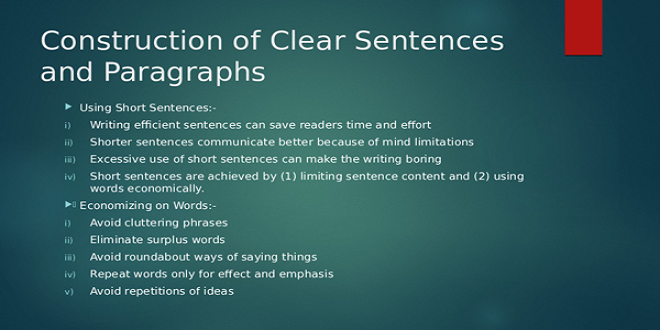Constructing sentences and paragraphs

In any document, it is important to get your construction right. When you are planning an oral report or presentation, the actual sentence and paragraph construction may not be as important, but even then the overall shape needs some thought, because that is what dictates the structure of what you are going to say: where you are going to pause, how you are going to divide your subject into easily absorbed segments, etc. No matter how interesting you try to make your subject, no matter how logical your argument is, people will find it difficult to follow if it is not well put together.
What Is a Sentence?
We all think we know what a sentence is – after all, we use them thousands of times a day. But are we quite sure that the sentences we use are real sentences?
So you cannot say, ‘I have received your letter. Which points out an error in your account.’ The second part of the passage is not a sentence, because there is no subject. The word ‘which’ is a relative pronoun, which introduces a description of the letter. The passage should read, ‘I have received your letter, which points out an error in your account.’
A common grammatical mistake in business communication is to write ‘non-sentences’ – passages that are used as sentences but do not contain both a subject and a predicate. This is not necessarily crucial when you are speaking, as the rules do not have to be applied quite so rigorously, but in correspondence it looks sloppy. So you should not say, ‘Hoping this meets with your approval.’ This is not a sentence; it has no subject. Who is hoping? You should say, ‘I hope this meets with your approval.’ Now there is a subject – ‘I’. It is also wrong to say, ‘There is only one problem. The cost.’ ‘The cost’ is not a sentence, as it has no predicate. This passage should read, ‘There is only one problem: the cost.’
Loose and periodic sentences
As you can see from these examples, loose sentences are more direct, and since one of the rules of business communication is to be direct, they are to be preferred. However, periodic sentences can be useful for building up to your subject, conveying a sense almost of suspense. They are therefore good for sales letters, where your aim is to hold the reader’s attention and make them want to know what is coming next. Look at the following extract
Sentence length
How long should your sentences be? The answer is ‘as long as necessary, but no longer’. This may not seem very helpful, but it is true – there is no ‘best’ length. It all depends on the circumstances. Short sentences generally give a sense of rapid movement and tension, a feeling of urgency. Longer ones are often used in descriptive passages, to develop your argument or perhaps to provide background information.
Because your aim is to be direct and brief, you should generally prefer short sentences. This is especially true when speaking, because if your sentences become too long you may well find it difficult yourself to keep track of what you are saying, let alone your audience! But do not feel that you must always use them. Apart from the fact that there are times when longer sentences are more in keeping with what you want to convey, it is also good to have a mixture of sentence lengths to avoid monotony and the ‘scrappy’ appearance of too many short, simple sentences.
Avoiding awkward sentences
There are several ways in which your sentences can become clumsy and awkward. Sometimes this is because they are incorrect grammatically, but even sentences that are quite correct can occasionally sound wrong. The most common causes of clumsy sentences are:
- incorporating two ideas in one sentence without a conjunction, relative pronoun or semicolon
- putting too many subsidiary clauses before the subject in a periodic sentence
- leaving hanging participles
- letting a sentence get out of parallel
We have already seen the awkward results of putting more than one idea in a single sentence, and the more you try to incorporate, the more unwieldy it becomes. Look at the following sentence, for example: ‘I am afraid that we are out of stock of that item and are not expecting new stocks for four weeks, at which time we will supply your order unless you decide that you would prefer to cancel, in which case I would be grateful if you would let me know.
Changing the emphasis in a sentence
You can change the emphasis in your sentences simply by changing the order of the words. The parts of a sentence that most people remember are the beginning and the end, so any points you want to emphasise should go there. Consider the following sentence: ‘I notified you three weeks ago that I had received the wrong consignment, and despite several telephone calls I have had no response to date.’ The emphasis here is on the notification and on the lack of response.
Building Sentences into Paragraphs
Just as a sentence should deal with a single idea, or two closely related ideas joined by a conjunction, relative pronoun or semicolon, so a paragraph should deal with just one collection of ideas, one theme or topic.
When written, it also looks difficult to read, so the reader is almost subconsciously put off before he or she even starts. Look at the passage below.
Paragraph length
As I have indicated, there are no precise rules about what constitutes a ‘topic’, so a certain amount of flexibility is possible in the length of your paragraphs. Short paragraphs are generally preferable to long ones. As you can see in the above examples, shorter paragraphs look easier to read, and if your readers think a document is going to be easy to read, then the battle for their attention is half won. If, on the other hand, you have very long paragraphs, your document will look boring, and you will have an uphill battle convincing your readers that it is not.
The topic sentence
Each paragraph should have what is called a topic sentence, one that encapsulates what the paragraph is going to be about. It should be at the beginning of the paragraph, usually the first sentence. Look at some of the examples above, and you will see the topic sentences:
The advantage of topic sentences is that they make it easier to follow the flow of your document by telling the reader what to expect from each paragraph. They might even be based on the points in your list outline.
Expanding your theme
As we have seen, the topic sentence introduces the theme, but you need to expand from that into a full paragraph. There are several techniques for this, depending on what you want to say. These are the most common:
Arguing your case
You might make a statement in your topic sentence and then explain it in the rest of the paragraph. For example: ‘We must be totally confident that you will be able to meet our deadline. It is extremely costly to have our machines lying idle. It is not only a question of having to pay operators when there is no work to be done, but the shut-down and start-up costs are extremely high.’ The topic sentence makes the statement, and the rest of the paragraph sets out the reasons why the deadline must be met.
Reinforcing your message
You might use the rest of the paragraph to emphasise the point made in your topic sentence by repeating it from a different perspective: ‘Our costs are rising at a worrying rate. Raw material prices increased by 15% this year. Overheads increased by 20%, partly because of an increase in our rent. And payroll costs increased by 10%, even though we actually saw a fall in the number of staff.’ Here the second, third and fourth sentences give examples of the way costs have risen, thus reinforcing the message of the topic sentence.
Outlining the consequences
You might make a statement in your topic sentence and then use the rest of the paragraph to show what the results might be: ‘We have not met our turnover budget this year. This means that we will have to reduce our overheads substantially next year. Redundancies will be inevitable.’
These are only the most common techniques for expanding your paragraph, and they are given here as suggestions only. Do not feel that that you must use them. There may be situations which you feel do not fit any of these techniques. In that case, develop your paragraph in the way you think suits the situation best. As long as the information is presented in a logical way, it does not matter a great deal what technique you use.
Getting the flow right
We have seen how you can expand your paragraph by developing the subject of your topic sentence logically. The same goes for the development of your document as a whole. It should flow logically, one topic leading on to the next. Conduct your audience through it without jumping from subject to subject. Each paragraph should have a natural connection with the previous one.
Last word
Very often, however, the new paragraph cannot be introduced by simply repeating an idea from the previous one. You may be about to change direction, or look at the same topic from a different angle. But you still need to make a link with what has gone before. You can use different expressions to make that link and indicate where you are going. Which one you use depends on what purpose the new paragraph serves, but here are a few examples.



